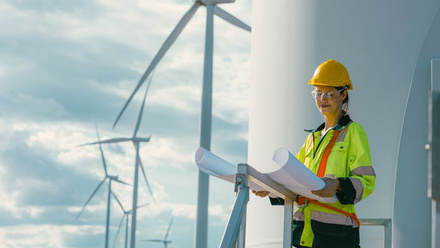Industry in transition
As Phase 3 of the UK's Industrial Energy Transformation Fund opens, previous grant recipients showcased how they are reducing their energy bills and emissions. Alex Brinded reports.

The relentless pursuit of manufacturing efficiency remains as vital now as during the Industrial Revolution, reflected Lord Callanan, UK Minister for Energy Efficiency and Green Finance.
He was speaking at a Technology Showcase event for projects funded under Phase 2 of the Industrial Energy Transformation Fund (IETF), held towards the end of last year.
Through the IETF, the UK Department for Energy Security and Net Zero (DESNZ) seeks to help high-energy-use businesses cut their carbon emissions and energy bills by increasing energy efficiency and decarbonising industrial processes.
These industrial sectors contribute around £180bln and provide 2.5mln direct jobs annually to the UK economy, Callanan shared. He recognised that industrial emissions have more than halved since 1990, but that emissions need to fall by two-thirds from today’s levels by 2035.
At a glance
The UK Government announced £315mln of funding for the Industrial Energy Transformation Fund in the 2018 Budget, available up until 2027.
An extension was announced in 2023, increasing grant funding by £185mln.
The government has run six competition windows to date. Phase 1 opened in 2020, and the final window of Phase 2 closed at the beginning of 2023.
Despite challenging economic circumstances, the government received a total of almost 500 project applications.
As of June 2023, funding has been allocated to over 130 projects and studies worth just under £160mln.
Aggregating the technologies
Rory Fulwell, a Decarbonisation Process Engineer at Leicester-headquartered Aggregate Industries, shared how the firm started a waste-heat recovery project for asphalt manufacturing eight months ago.
The raw materials of quarried aggregates, recycled asphalt and bitumen are usually dried and heated in a large, direct-fired rotary dryer prior to mixing and hot storage. They mix mostly using batch plants but do have some continuous feed plants, although Fulwell noted these are generally new.
Wanting to improve efficiency, they discovered that the exhaust air comes out at about 175°C, generally ranging from 150-200°C depending on the product. They realised that they only need the exhaust heat to be around 70°C to prevent their cloth filters accruing moisture, and they can remove the thermal energy without impacting the process.
The company has developed a pre-combustion, air-heating system that passes exhaust gases through a heat exchanger and dryer. They use those gases to warm up the inlet air coming into the dryer. So instead of the inlet air coming in at 10°C, it now comes in at 70°C with the potential to be at 90°C.
They are talking to the manufacturers of the burner equipment about the possibility of raising the circulated air to 90°C, as the burner has sensitive components.
Fulwell shared how this would enable them to save 2.5mlnkW of energy, 350t of CO2 and £90,000 of their fuel budget a year at the site where this was trialled in Tyldesley, Manchester, in partnership with Aston University.
They plan to trial this system further at sites in Wigan and Astley this year, and then expand the scope to about 45 sites.
Fulwell explained that there are customisations required at the different sites, and an IETF grant has helped to reduce the risk, enabling the recruitment of new staff, including himself.
Marginal grains
Operations Director Stephen Rowley from Simpsons Malt in Berwick-upon-Tweed in Northumberland, on the border between England and Scotland, presented the company’s electric boiler plans.
The maltsters and grain merchants originated in 1862 and has been located at the Berwick site since 1963. It processes nearly 250,000t of grain, of which 85% goes North for distilling, shared Rowley, making it the single largest malting site in the UK. He commented that many customers are pushing them to decarbonise, so it is an easy sell.
In 2022, their two biggest energy use areas were carbon fertiliser and fuel for kilning. As malted barley is 95% water, the moisture needs removing down to about 4%.
Their concept uses a primary baseload heat of 18MW of biomass and 4MW of relocated Renewable Heat Incentives. Their secondary heat source uses 12MW of constrained wind from the grid, with a final back-up of grid gas.
Three biomass boilers store the energy. When wind is constrained, they provide a ‘turn on’ service to balance the grid. They bid in through the Balancing Mechanism market for wind energy. If there is no wind and their demand exceeds 18MW, they top up with gas – which Rowley said was relatively infrequent – around 5% of the time.
Simpsons’ kilning process uses roughly 145mlnKW of gas, which is going to be reduced by 90%, saving 25,000t of carbon per annum, which is more than half the gas used by the town of Berwick-upon-Tweed.
The project was possible due to investment from AMP Clean Energy, based in London, with a long-term contract for the sale of low-carbon energy to Simpsons by AMP building an energy centre next-door to the malting site.
The IETF grant was invaluable to bring new technology into play, explained Stuart Reid, Head of Net Zero Customer Solutions at AMP. He noted that, 'Our big vision is to increase opportunities to use flexible electrification to help industries decarbonise.'
He described electrification as 'hard' and expensive', whereas flexible electrification identifies mismatches between producers and users. He explained how AMP Clean Energy own a portfolio of assets that ‘turn on’ when there is a deficit of wind.
Rock-solid benefits
Managing Director Greg Hewitt from Rock Oil explained how the company has changed its blending process.
The 95-year-old company in Cheshire blends lubricants mainly for domestic use, delivering 20mlnL a year, with 60mlnL manufacturing capacity. Raw materials include base oils and additives or performance chemicals.
These raw materials were previously blended in a diesel heating process that generated steam, which is piped in to mix at 40-60°C depending on the product for about two hours while the product is homogenised.
The new ultrasonic blending process uses a pulse to blend these ingredients at an ambient temperature in the existing vessel. As no heat is required, Rock Oil has reduced its energy consumption by 90%, with a 70% reduction in the kWh consumption per metric tonne produced, explained Hewitt. Having previously used 2,172MWh annually, the company expects to use 633MWh – a £72,000 p.a. saving. They are reviewing how to reduce energy usage further using solar panels.
Benefits include improved air quality for workers, and with vessels at ambient temperature, it is also both safer and more efficient to take samples, as the product can be moved immediately without cooling.
Their current partner Blendtek supplied the technology, with the IETF grant de-risking the project. Hewitt noted how the funding catapulted them forward during the COVID-19 pandemic, leap-frogging a three-to-four year wait.
He reported installation was straightforward with minimal downtime, and blending capacity actually increased. Blends only take 15-30 minutes.
Casting the net wider
We last heard from Jake Solomon at Birmingham-based JW Lunt – a metal-castings art sculpture business dating back to the 1930s. Solomon reported how an electric induction kiln has modernised their processes.
Having purchased the business just before the pandemic, he found aspects stuck in the 1970s, such as the insulation and lighting.
With each stage of the process using natural gas and rising energy costs, they started a small, affordable project to gauge the impact of switching to an electric induction furnace, made possible by the IETF.
In just six weeks, Solomon reported a reduction in the firm’s carbon footprint by 40% overall. However, they still bake the moulds in a gas-fired kiln at 750°C for 24 hours minimum, and this heat is not recaptured.
The company is planning to install solar panels to provide 90% of the furnace’s energy in the summer, dropping to 50% in the winter. Solomon also plans to install solar and battery storage in Q2 of 2024.
Supplementary benefits include the kiln never getting hot, which saves on manual handling and means placing moulds is easier. The slag is easily removable.
The more impurities in the metal, which Solomon noted was unavoidable, the higher the chance of recasting the product. They make 3,000 parts a month but recast probably 200-250, and are hoping this electric induction kiln is going to save them money and increase efficiency.
However, completely switching all processes to electric would require three times the investment. He noted many other small manufacturing businesses in Birmingham would similarly struggle to spend £100k on new equipment on their own.
Taking everyone along for the journey
For the panel discussion on what industry can do in the next 10 years, Technical Director Dirk Alderhold of Atomising Systems explained the challenges facing many companies, including his.
Alderhold shared how the metal-powder manufacturers use 'extremely high temperature' and need 'cheap, green electricity'. He posited forms of support for high-energy industries such as solar panel installation tax breaks. They are currently installing panels using private funds that will only provide 10% of their electricity. He noted that countries like the Netherlands offer low-interest loans over a long period.
Senior Manager Simon Foster at Toyota’s 31-year-old motor manufacturing site in Deeside, Cheshire, detailed his company’s focus to survive as the combustion-engine is phased out. Their 16-year-old, ZR engine line casts, machines and tests 94% hybrid engines. Aiming to be a carbon-neutral manufacturing site by 2025 with a new powertrain, Foster believes their skills are transferable to new technologies.
He reported emissions reductions over the last 20 years of 91% through technology, solar panels, heat recovery systems, better control and removing wasteful processes, such as an inefficient casting plant with a 23-year-old furnace.
Government funding has enabled them to increase efficiency, which has reduced their carbon emissions by 31%, and their furnace pouring process from 3 minutes 50 seconds to 42 seconds, with a dramatic reduction in maintenance costs.
To tackle the remaining 9% of emissions onsite, they plan to partner with a waste-to-energy company to make biomethane with anaerobic digestion, as their furnaces can now use biomethane or hydrogen. Foster suggested the site can further improve by leading on hydrogen by 2030.
Rachel Armstrong, Director for Industrial Decarbonisation and Emissions Trading from DESNZ, urged all attendees to future-proof their businesses by thinking out to 2050, as waiting for solutions by 2030 or 2035 would leave them behind.
She warned that Europe now had a Carbon Border Adjustment Mechanism, but the pricing around it may change, and urged company representatives to 'ask yourself, are you making strange engineering choices because of the economic distortions?'
She also called for more businesses to collaborate locally on energy solutions and think about Scope 3 emissions more.
Michael Lord, Senior Industry Analyst at the Climate Change Committee – the government’s independent advisor, added that the five-year Carbon Budget 4 is starting now.
He noted that industrial decarbonisation was appearing in Carbon Budgets 5 and 6, which means 'things really have to accelerate – carbon capture and storage and fuel switching, particularly electricity and hydrogen, and some biomass.'
He was really inspired to hear the stories of individual progress despite concerns about the big picture. 'Our assessment is that it is not going to happen at the moment with current policy and current action on the ground. Our reports have not been very positive…We are only gloomier about agriculture.' And despite focus on industrial clusters, Lord commented that about half of industrial emissions were elsewhere.
He, however, noted the progress made by the steel industry since their last assessment due to the move towards electrification. 'But it costs several multiples of gas and kills the business case…we need to tackle it.
'One reason this is frustrating is that I often hear about case studies or feasibility studies where electrification could happen at an industrial site at pace and easier than carbon capture and storage...but there is no business case...Those opportunities are going begging because there isn’t a mechanism for them to happen.'
Lord acknowledged the Business Supercharger Fund goes some way to dealing with this.
Animesh Ghosh from the SME engineering consultancy Envirya in Watford reported the primary objective for its clients is always energy saving in terms of financial saving.
'In 30 years or so, I have not seen a client say that carbon savings comes first and financial saving next.' He emphasised data collection as a lot of companies do not really understand how they use energy.
Like Alderhold, he reflected on solar panels use in Europe, where they supply to the grid. Energy can be transferred across sites, and he has clients who would like to transfer their energy across sites. The call for more incentives was clear.
Armstrong added that in the context of the UK Emissions Trading Scheme, 'it will be a double fail if we do not decarbonise and just offshore the emissions and lose the economy, and then generate more emissions by transporting products back into the UK'.
The next phase
With some of the projects funded by Phase 2 of the Industrial Energy Transformation Fund (IETF) presented at the Technology Showcase event, Phase 3 was waiting in the wings.
Lily Tozer from UK Department for Energy Security and Net Zero acknowledged at the event that the manufacturing industry’s energy transition 'is a really huge challenge, but it is one we have to meet'.
Tozer announced £185mln to be available for Phase 3, with two competition windows – from January to April 2024, with the second towards the summer. Tozer recommended getting in the application as early as possible and highlighted that all successful projects must be completed by March 2028.
The three strands are energy efficiency, decarbonisation, and feasibility and engineering studies.
The energy efficiency strand is for any project that can save the energy required for industrial work, so not lighting or space heating. The applicants can choose how to do that as the fund is technology neutral, and they can apply on their own or with a partner. Examples include process optimisation, equipment upgrades, process heat, energy recovery systems and heat pumps, as well as resource-efficiency measures. Tozer noted that applicants are unlikely to be successful if looking to replace old equipment that needs upgrading.
For the decarbonisation strand, projects must reduce emissions only through industrial processes at site level. This can be through fuel switching to a lower-carbon-intensive fuel. It includes electrification, retrofits and upgrades, although Tozer warned that there are strict rules around biogas and biomass. This strand also includes onsite carbon capture for utilisation or storage if applicants can demonstrate the end-use for that carbon.
The last strand on feasibility and engineering studies is for companies who have not yet decided exactly how to decarbonise and want more information.
Changes to the scope of Phase 3 following consultation feedback included reducing the minimum threshold for SMEs to £75k from £100k. Also, additional sectors can apply, such as controlled environmental horticulture, industrial laundries and textile renting facilities. Tozer noted that coal-mining activities are no longer eligible. However, businesses registered in Scotland, but with sites in other parts of the UK, can apply. The IETF will also continue to provide funding for site relocations, subject to constraints.
Tozer explained that as there are emerging technologies that are not yet demonstrated, they want to enable companies to use these where possible, and so the IETF is lowering the Technology Readiness Level threshold for the energy efficiency strand to a 7, matching the decarbonisation strand, to help commercialise newer technologies.
Timelines typically would include a month or so for an eligibility check, nine months for assessment and recommendations to ministers and then the IETF would work alongside businesses to set up the grant award, which can take one to three months.
Tozer concluded by saying that applicants can get an uplift on the standard subsidy intensity percentages for specific reasons, such as if they operate within areas of low economic advantage, similarly the studies can get an uplift if they can demonstrate knowledge sharing.
Read more about IETF Phase 3 funding.







